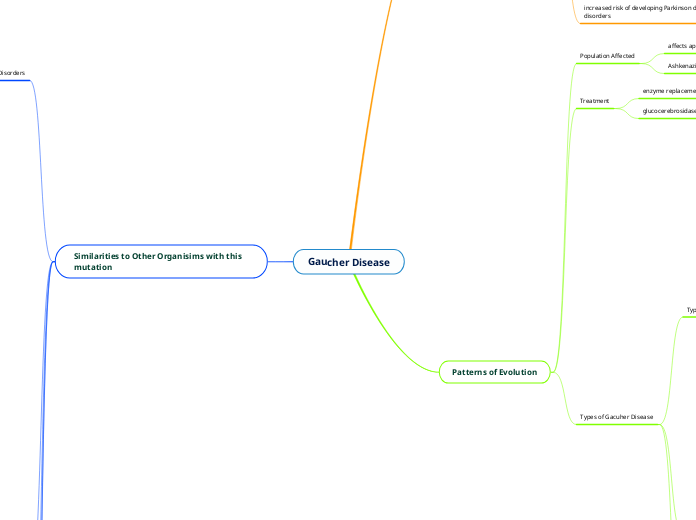Gaucher Disease
How the Mutation Arose
passed down from parent to child
GBA gene (glucosylceramidase beta)
50% of people diagnosed are under the age of 20
verified by a beta-glucosidase leukocyte (BGL) test
lack of phenotypes
Transmission from carrier parents
1 in 4 (25 percent) chance to have a baby born with Gaucher disease
1 in 2 (50 percent) chance to have a child who is a carrier like themselves
1 in 4 (25 percent) chance to have a child who is neither affected nor a carrier
it is an autosomal recessive inherited disorder that affects the metabolism
increased risk of developing Parkinson disease and related disorders
Patterns of Evolution
Population Affected
affects approximately 1 in 100,000 persons
Ashkenazi Jewish population 1 in 500 persons
Treatment
enzyme replacement therapy
glucocerebrosidase enzyme given intravenously
Types of Gacuher Disease
Type 1 is called non-neuronopathic
affects 90% of people
It is treatable.
don't have enough platelets in their blood
bruise easily and feel tired often
Blood leaks out of vessels and appears as dark matter under the skin.
Small blood vessels (cappilaries) are broken
Legs
Blow/Injusry
Arms
Blow/Injusry
Skin becomes thinner
protective fatty layer that helps cushion blood vessels from injury gets thinner
Corticosteroids thin the skin, making it easier to bruise
Some dietary supplements, such as ginkgo biloba, have a blood-thinning effect.
Women more prone than men
history of excessive or prolonged bleeding
Minor cut
Surgical procedure
Subtopic
enlarged liver or spleen
possibly kidney, lung, and skeletal problems
How platelets function
Proteins in blood
lack of primary central nervous system involvement
Type 2 is called acute neuronopathic
affects newborns and infants
It is fatal
abnormal accumulation of glucocerebroside in the brain
primary central nervous system involvement
neurological impacts
Type 3 is chronic neuronopathic
skeletal problems
blood disorders
breathing problems
liver and spleen enlargement
primary central nervous system involvement,
neurological impacts
seizures
eye movement disorders
It is treatable
Similarities to Other Organisims with this mutation
Monogenetic Inheritance Disorders
Iron overload (hemochromatosis)
Hemochromatosis
body stores too much iron
Help hemoglobin in blood cells carry oxygen throughout your body.
Make red blood cells
Damage to heart
Arrythmia (irregular heartbeat)
Heart failure
Damage to liver
Cirrhosis (scarring)
Enlarged liver
Liver cancer
Liver failure
damage to pancreas
Arthritis (joint damage)
Diabetes
Problems with the spleen, adrenal glands, pituitary gland, gallbladder or thyroid
Grey Skin
Reproductive System issues
Erectile dysfunction
early menopause in women
Sickle cell anemia
Shape of red blood cells
Shaped like sickles
Sticky and stick to walls of veins
Painful
No Cure
Red blood cells die in 10 days instead of 120
Intense pain for days
Swelling of hands and feet
Damage Spleen
Infections
Pneumonia
Delayed puberty
Vision Problems
Marfan syndrome
Connective tissue
Heart
Eyes
Blood Vessels
Skeleton
Huntington's disease
degeneration of nerve cells in the brain
Movement Disorder
Cognitive Disorder
Psychiatric Disorder
Cystic fibrosis
Damage to Lungs
Damage to digestive system
Affects cells that makes mucus
Affects cells that makes sweat
Affects cells that make digestive juices
Secretions are thick and clog up the body
Treatment but no cure
Life expectancy only into their 50's
multifactorial inheritance disorders
Diabetes
Cancer
Alzheimer's disease
Cancer
Gene Mutation
glucocerebrosidase
glucocerebroside fat can't be broken down
Fat Accumulates in:
Liver
Spleen
Bone Marrow
Pain
Fatigue
jaundice
Bone damage
anemia
death
genotypes (N370S) encodes an enzyme that has sufficient residual enzyme activity to ensure that significant neurologic disease does not occur
two copies of the N370S mutation of the GBA gene
affects chromosome 1q21
